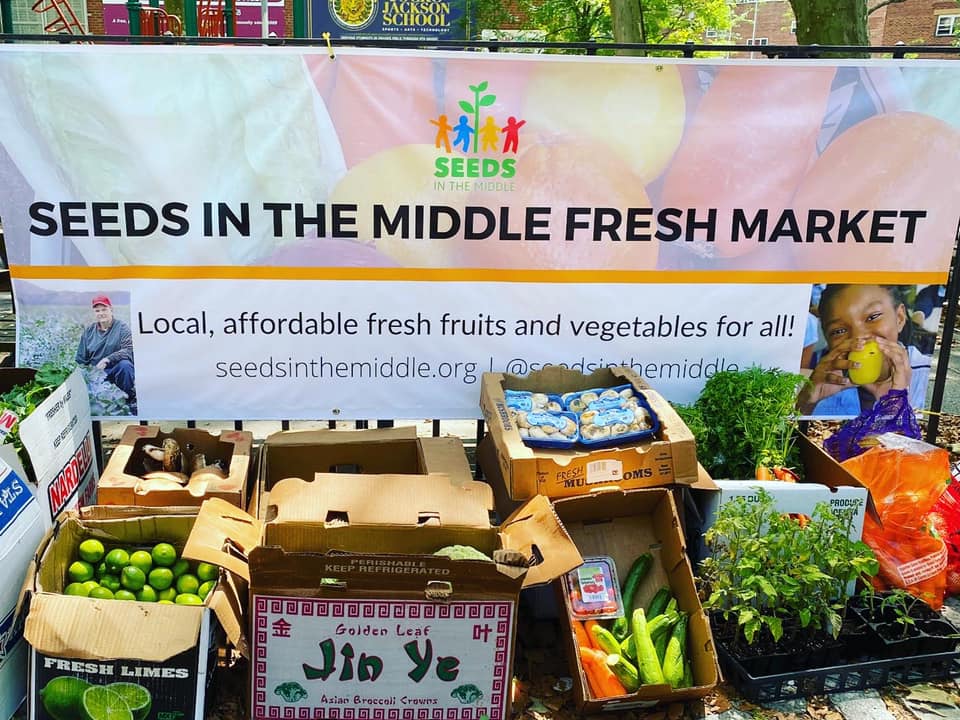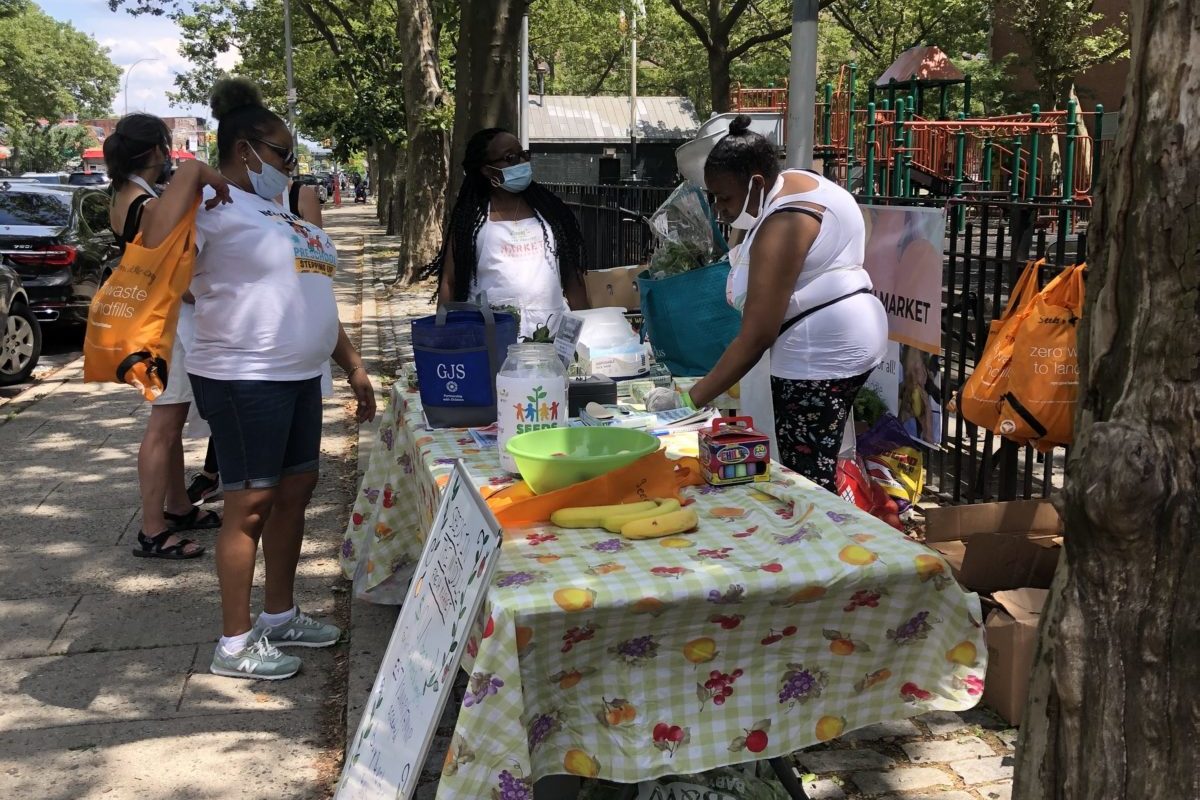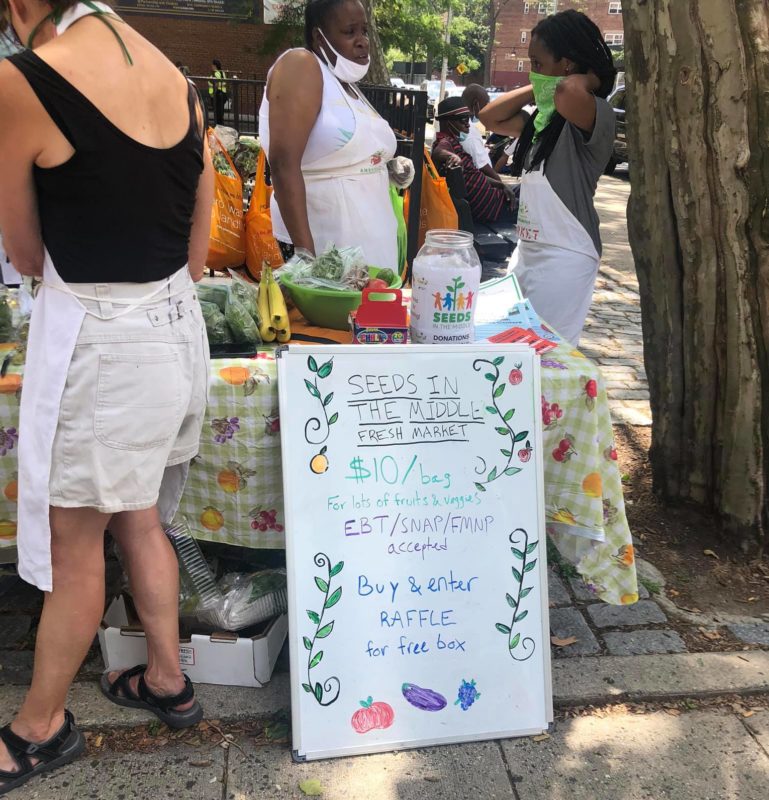Seeds in the Middle Brings Fresh Produce Programs to Food Insecure Areas of Brooklyn


On Pitkin Avenue in Brownsville, there are five fast food restaurants in a small stretch. Lifetime neighborhood resident Nora Rodríguez Cortez says that there are far fewer supermarkets, only around three, and that at the bodegas fresh produce is hard to come by.
Seeds in the Middle is trying to change that and opened two new fresh markets last week, one in Brownsville and one in Flatbush. These markets, held outside public schools in the area, were purposefully placed in Central Brooklyn areas that have been plagued by food insecurity, a problem only exacerbated by the Coronavirus pandemic.
Nancie Katz, a former journalist for the Daily News, started Seeds in the Middle over ten years ago.
The program works to bring fresh produce to lower income neighborhoods in Central Brooklyn by building gardens in schools and teaching kids how to sell the produce, both that they grow and that is donated by local restaurants and stores, with a goal of teaching business and healthy eating skills. They also host events like cooking classes with local chefs, in which families can learn how to make a healthy meal for less than the cost of a fast-food combo.

“Seeds in the Middle is about teaching a man or a woman to fish. We’re not a program that just gives away to the poor. We’re an educational program. We recognize that there is no fresh food or opportunity for nutrition in our low income neighborhoods,” Katz said.
COVID-19 related shutdowns have forced them to make changes to the way they once did things, as well as brought new challenges, like having to station the markets on sidewalks instead of within school grounds, something that requires its own set of permits and regulations.
Katz says that things that are a “yes” in a neighborhood like Crown Heights are often a “no” in a neighborhood like Brownsville, as in higher income neighborhoods even if permits are initially denied or politicians decline to fund programs, parent groups are more likely to get involved and lobby on behalf of the projects.
“Why can GrowNYC have farmer’s markets on the sidewalk and we can’t?” Katz asked.
Rodríguez Cortez, a photographer and lifelong Brownsville resident, says that programs like Seeds in the Middle are necessary.
“Is it important? Yes. It’s essential. We [can] start to educate our children at a young age on properly eating healthy,” Rodríguez Cortez said, adding that there are really only three grocery stores in the neighborhood, some of which require long walks. “On every corner you find a bodega. The bodegas don’t carry fresh fruits and veggies, all you find is junk food.”
Aycan Yurdakul, an artist who volunteers with Seeds in the Middle, also feels as though this is what neighborhoods need right now.
“These days I feel like this is what we need most to be able to help people to eat healthier and help them to have access to healthy food. I think this is the most important thing right now,” Yardakul said.

Seeds in the Middle, Katz says, is a small operation that has long struggled with funding, even going bankrupt and shutting down for a period in 2014. Money comes from a variety of sources, including the New York State Agriculture Association, City Council, and school fundraisers, with help from organizations like IOBY.
“Whatever the money’s been invested in the last ten years has obviously failed,” Katz said. Rodríguez Cortez agrees that more necessary programs are often cast aside in favor of hotels, fast food, and “affordable” housing that no one can afford. She also jokes that she sometimes says “defund Brownsville”, as the current funding isn’t helping as it should.
The COVID-19 pandemic has brought attention to all of this, Katz says.
“It really put a spotlight on the thing that we’ve been trying to spotlight for ten years. There’s no access to fruits and vegetables and these people really want it. We opened [the fresh market] in Brownsville and we already have requests for more,” she added.
Seeds in the Middle also hosts a Taste of Brooklyn charity event, a restaurant crawl with proceeds going towards the kids in the programs. The event has happened since 2011, but this year will be a bit different.
“This time it has two missions. Usually, the businesses will donate to us because they’re helping the kids, but we know they’re in trouble this round so we’re trying to raise money to pay the businesses. I’ve been feeling really bad for all of our restaurants that supported us all these years, they’re really suffering,” Katz said.
The event this year will still be a crawl and will be held on August 1st. In addition to the cost of the ticket, attendees can donate extra to business support if they so choose. Katz added that they will need to raise between $5,000 and $10,000 in order to pay the businesses fairly. Volunteers will also be present the day-of to ensure distancing and mask-wearing is enforced.
Katz hopes to highlight the people in neighborhoods like Brownsville who ensure the success of these programs, as well.
“We hope that people will see that these people are movers and shakers, and gracious and humble and smart, and they just need to be supported. We need to shine lights on them,” Katz said. “These people are really doing the work, and are never seen.”




